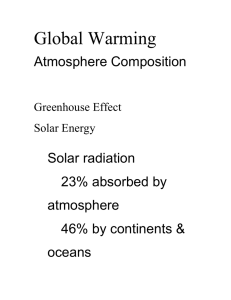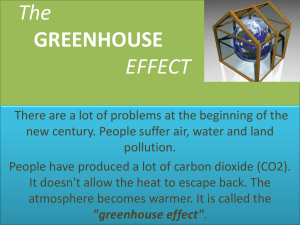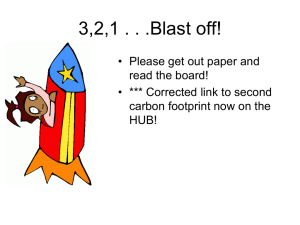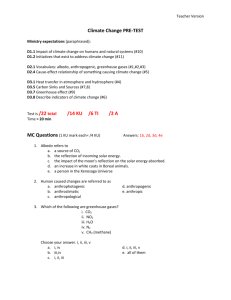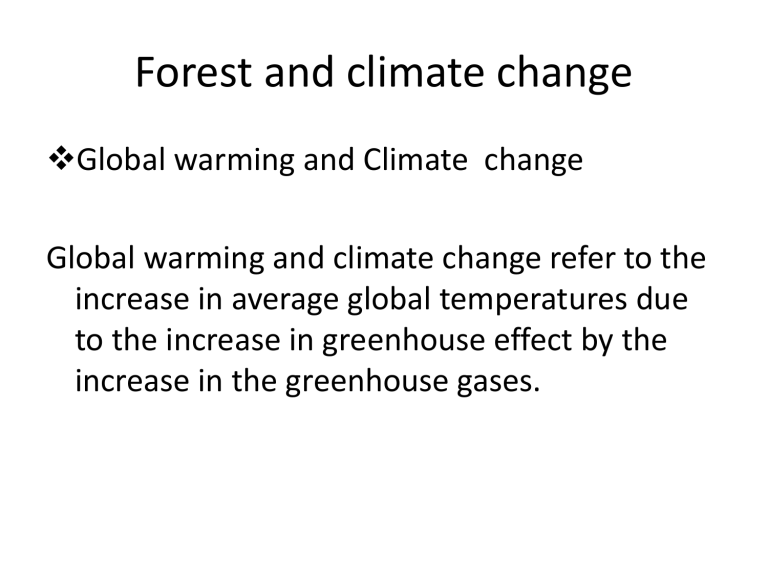
Forest and climate change Global warming and Climate change Global warming and climate change refer to the increase in average global temperatures due to the increase in greenhouse effect by the increase in the greenhouse gases. Causes of climate change 1. Natural event : forest fires, volcanic eruptions, methane release from thawing of permafrost on the ocean floor and release of methane gas from cattle, wet lands 2. Anthropogenic activities : fossil oil combustion, industrial production of greenhouse gases, agricultural water lodging activities such as paddy cultivation artificial wet lands and deforestation. Greenhouse effect • Weather and climate of the earth is driven by the sun’s energy. • Solar radiation heats the earth surface, and in turn earth radiates the energy back into space. • Some gasses of the atmosphere traps some of the outgoing energy and retains heat. • This causes to an increase in the global temperature and also causes subsequent changes in the weather pattern. Greenhouses gases • • • • • • CO2 -Carbon dioxide CH4-Methane N20-nitrous oxide HFC-hydro fluorocarbon CFC-chlorofluorocarbon CF4-Carbon tetra fluoride Major sources of Greenhouse gases ENERGY Forest fuel combustion ; Natural gas leakage ; Industrial activities; Biomass burning CO2, CH4, N2O, O3 FOREST Harvesting , Clearing . Burning CO2, CH4, N2O AGRICULTURE Paddy fields , Animal husbandry (ruminants) , Fertilizer usage CO2, CH4, N2O WASTE MANAGEMNT Sanitary landfill Incineration Biomass decay CO2, CH4, N2O, O3, CFCs INDUSTRIES Metal smelting & processing ; Cement production ; Petrochemical production; Miscellaneous CO2, CH4, N2O, CFCs, SF6, CF4, C2F6 Impacts of global warming • Sea level rise • Melting down of ice • Extreme events (flood & landslides, Hurricanes and Tornadoes, droughts and fires, heat waves) • Effect on biodiversity • Health effects Key definitions • • • • • Carbon pool: A reservoir of carbon. A system which has the capacity to accumulate or release carbon. Carbon stock: The absolute quantity of carbon held within a pool at a specified time. The units of measurement are mass. Carbon flux: Transfer of carbon from one carbon pool to another in units of measurement of mass per unit area and time (e.g., t C ha-1 yr1) Carbon sink: Any process or mechanism which removes a greenhouse gas, an aerosol or a precursor of a greenhouse gas from the atmosphere. A given pool (reservoir) can be a sink for atmospheric carbon if, during a given time interval, more carbon is flowing into it than is flowing out. Sequestration (uptake): The process of increasing the carbon content of a carbon pool other than the atmosphere.(IPCC, 2000). Roles of forestry in climate change • Forests are important carbon pools which continuously exchange CO2 with the atmosphere. • Organic matter contains carbon susceptible to be oxidized and returned to the atmosphere in the form of CO2. Carbon is found in several pools in the forest: Con’t • the vegetation: living plant biomass consisting of wood and non-wood materials. • dead wood and litter: dead plant biomass, made up of plant debris. • soil organic matter, the humus. Humus originates from litter decomposition. • Wood products derived from harvested timber are also significant carbon pools. Process of CO2 emission The oxidation of carbon found in organic matter and the subsequent emissions of CO2 result from the following processes: • respiration of living biomass, • decomposition of organic matter by other living organisms (also called heterotrophic respiration), • combustion (fires) Diagram of Carbon cycle in forest Forestry activities to mitigate climate change Several actions can be taken in the forestry sector in order to mitigate climate change. • Plant trees to create carbon sinks Planting new forests, rehabilitating degraded forests and enriching existing forests • Protect existing forests to reduce emissions from deforestation • The carbon reservoir in the forest biomass and soils is very large, highlighting the importance of conserving natural forests.


